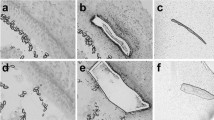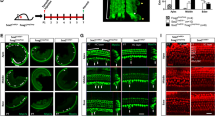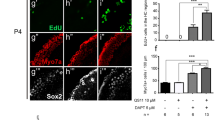Abstract
The transcription factor FOXO3 is necessary to preserve cochlear hair cells. Growth factors, including TGF-β, closely contribute to cochlear hair cell regeneration. In the present study, to investigate the roles of FOXO3 in the ciliogenesis and cell functions of cochlear hair cells, UB/OC-2 temperature-sensitive mouse cochlear precursor hair cells were treated with TGF-β receptor type 1 inhibitor EW-7197 or EGF receptor inhibitor AG-1478 after transfection with or without siRNA-FOXO3a. GeneChip analysis revealed that treatment with EW-7197 increased Foxo3 genes and decreased genes of Smads. During cell differentiation, treatment with EW-7197 or AG-1478 induced an increase in length of cilia-like structures that were positive for acetylated tubulin and inhibited cell migration. Treatment with EW-7197 also increased cell metabolism measured as mitochondrial basal respiration (oxygen consumption rate). The effects of EW-7197 were stronger than those of AG-1478. Knockdown of FOXO3 prevented the growth of cilia-like structures induced by EW-7197 or AG-1478 and induced cell migration under treatment with EW-7197. No change of the epithelial cell polarity molecule PAR3 was observed with any treatment. Treatment with the antimicrobial agent amikacin prevented the growth of cilia-like structures induced by EW-7197 and induced apoptosis. Pretreatment with the glucocorticoid dexamethasone inhibited the apoptosis induced by amikacin. This in vitro model of mouse cochlear hair cells suggests that FOXO3/TGF-β signaling plays a crucial role in ciliogenesis and cell functions during differentiation of cochlear hair cells. This model is useful for analysis of the mechanisms of hearing loss and to find therapeutic agents to prevent it.







Similar content being viewed by others
References
Aksoy F, Dogan R, Ozturan O, Eren SB, Veyseller B, Pektas A, Hüseyinbas Ö (2014) Protective effect of trimetazidine on amikacin-induced ototoxicity in rats. Int J Pediatr Otorhinolaryngol 78:663–669
Borck G, Ur Rehman A, Lee K, Pogoda HM, Kakar N, von Ameln S, Grillet N, Hildebrand MS, Ahmed ZM, Nürnberg G, Ansar M, Basit S, Javed Q, Morell RJ, Nasreen N, Shearer AE, Ahmad A, Kahrizi K, Shaikh RS, Ali RA, Khan SN, Goebel I, Meyer NC, Kimberling WJ, Webster JA, Stephan DA, Schiller MR, Bahlo M, Najmabadi H, Gillespie PG, Nürnberg P, Wollnik B, Riazuddin S, Smith RJ, Ahmad W, Müller U, Hammerschmidt M, Friedman TB, Riazuddin S, Leal SM, Ahmad J, Kubisch C (2011) Loss-of-function mutations of ILDR1 cause autosomal-recessive hearing impairment DFNB42. Am J Hum Genet 88:127–137
Chishti MS, Bhatti A, Tamim S, Lee K, McDonald ML, Leal SM, Ahmad W (2008) Splice-site mutations in the TRIC gene underlie autosomal recessive nonsyndromic hearing impairment in Pakistani families. J Hum Genet 53:101–105
Di Vincenzo S, Sangiorgi C, Ferraro M, Buscetta M, Cipollina C, Pace E (2021) Cigarette smoke extract reduces FOXO3a promoting tumor progression and cell migration in lung cancer. Toxicology. https://doi.org/10.1016/j.tox.2021.152751
Gerdes JM, Davis EE, Katsanis N (2009) The vertebrate primary cilium in development, homeostasis, and disease. Cell 137:32–45
Gilels F, Paquette ST, Zhang J, Rahman I, White PM (2013) Mutation of Foxo3 causes adult onset auditory neuropathy and alters cochlear synapse architecture in mice. J Neurosci 33:18409–18424
Gilels F, Paquette ST, Beaulac HJ, Bullen A, White PM (2017) Severe hearing loss and outer hair cell death in homozygous Foxo3 knockout mice after moderate noise exposure. Sci Rep 7:1054
Higashi T, Tokuda S, Kitajiri S, Masuda S, Nakamura H, Oda Y, Furuse M (2013) Analysis of the ‘angulin’ proteins LSR, ILDR1 and ILDR2––tricellulin recruitment, epithelial barrier function and implication in deafness pathogenesis. J Cell Sci 126:966–977
Ikenouchi J, Sasaki H, Tsukita S, Furuse M, Tsukita S (2008) Loss of occludin affects tricellular localization of tricellulin. Mol Biol Cell 19:4687–4693
Jagger DJ, Holley MC, Ashmore JF (1999) Ionic currents expressed in a cell line derived from the organ of Corti of the Immortomouse. Pflügers Arch 438:8–14
Kakiuchi A, Kohno T, Kakuki T, Kaneko Y, Konno T, Hosaka Y, Hata T, Kikuchi S, Ninomiya T, Himi T, Takano K, Kojima T (2019) Rho-kinase and PKCα inhibition induces primary cilia elongation and alters the behavior of undifferentiated and differentiated temperature-sensitive mouse cochlear cells. J Histochem Cytochem 67:523–535
Kawamoto K, Yagi M, Stöver T, Kanzaki S, Raphael Y (2003) Hearing and hair cells are protected by adenoviral gene therapy with TGF-α1 and GDNF. Mol Ther 7:484–492
Kikuchi S, Ninomiya T, Kawamata T, Tatsumi H (2008) Expression of ASIC2 in ciliated cells and stereociliated cells. Cell Tissue Res 333:217–224
Kitajiri S, Katsuno T (2016) Tricellular tight junctions in the inner ear. Bio Med Res Int 216:1–5
Kitajiri S, Katsuno T, Sasaki H, Ito J, Furuse M, Tsukita S (2014) Deafness in occludin-deficient mice with dislocation of tricellulin and progressive apoptosis of the hair cells. Biol Open 3:759–766
Ladrech S, Eybalin M, Puel JL, Lenoir M (2017) Epithelial-mesenchymal transition, and collective and individual cell migration regulate epithelial changes in the amikacin-damaged organ of Corti. Histochem Cell Biol 148:129–142
Landin Malt A, Dailey Z, Holbrook-Rasmussen J, Zheng Y, Hogan A, Du Q, Lu X (2019) Par3 is essential for the establishment of planar cell polarity of inner ear hair cells. Proc Natl Acad Sci U S A 116:4999–5008
Lee JH, Oh SH, Kim TH, Go YY, Song JJ (2017) Anti-apoptotic effect of dexamethasone in an ototoxicity model. Biomater Res 21:4
Li L, Qi L, Liang Z, Song W, Liu Y, Wang Y, Sun B, Zhang B, Cao W (2015) Transforming growth factor-beta1 induces EMT by the transactivation of epidermal growth factor signaling through HA/CD44 in lung and breast cancer cells. Int J Mol Med 36:113–122
Liu S, Zhang X, Sun M, Xu T, Wang A (2017) FoxO3a plays a key role in the protective effects of pomegranate peel extract against amikacin-induced ototoxicity. Int J Mol Med 40:175–181
McGrath J, Roy P, Perrin BJ (2016) Stereocilia morphogenesis and maintenance through regulation of actin stability. Semin Cell Dev Biol 65:88–95
Michalopoulos A, Papadakis E (2010) Inhaled anti-infective agents: emphasis on colistin. Infection 38:81–88
Murillo-Cuesta S, Rodríguez-de la Rosa L, Contreras J, Celaya AM, Camarero G, Rivera T, Varela-Nieto I (2015) Transforming growth factor beta1 inhibition protects from noise-induced hearing loss. Front Aging Neurosci 7:32
Riazuddin S, Ahmed ZM, Fanning AS, Lagziel A, Kitajiri S, Ramzan K, Khan SN, Chattaraj P, Friedman PL, Anderson JM, Belyantseva IA, Riazuddin S, Friedman TB (2006) Tricellulin is a tight-junction protein necessary for hearing. Am J Hum Genet 79:1040–1051
Rivolta MN, Grix N, Lawlor P, Ashmore JF, Jagger DJ, Holley MC (1998) Auditory hair cell precursors immortalized from the mammalian inner ear. Proc Biol Sci 265:1595–1603
Romand R, Chardin S (1999) Effects of growth factors on the hair cells after ototoxic treatment of the neonatal mammalian cochlea in vitro. Brain Res 825:46–58
Satoh H, Billings P, Firestein GS, Harris JP, Keithley EM (2006) Transforming growth factor beta expression during an inner ear immune response. Ann Otol Rhinol Laryngol 115:81–88
Takano K, Kakuki T, Kaneko Y, Kohno T, Kikuchi S, Himi T, Kojima T (2017) Histone deacetylase inhibition prevents cell death induced by loss of tricellular tight junction proteins in temperature-sensitive mouse cochlear cells. PLoS One. https://doi.org/10.1371/journal.pone.0182291
Tarchini B, Lu X (2019) New insights into regulation and function of planar polarity in the inner ear. Neurosci Lett. https://doi.org/10.1016/j.neulet.2019.134373
Tokgoz B, Ucar C, Kocyigit I, Somdas M, Unal A, Vural A, Sipahioglu M, Oymak O, Utas C (2011) Protective effect of N-acetylcysteine from drug-induced ototoxicity in uraemic patients with CAPD peritonitis. Nephrol Dial Transplant 26:4073–4078
Wang D, Zhou J (2021) The kinocilia of cochlear hair cells: structures, functions, and diseases. Front Cell Dev Biol. https://doi.org/10.3389/fcell.2021.715037
White PM (2016) The role of the transcription factor Foxo3 in hearing maintenance: informed speculation on a new player in the cochlea. Biomed Res Int 2016:1870675
Zhao Y, Ma J, Fan Y, Wang Z, Tian R, Ji W, Zhang F, Niu R (2018) TGF-beta transactivates EGFR and facilitates breast cancer migration and invasion through canonical Smad3 and ERK/Sp1 signaling pathways. Mol Oncol 12:305–321
Zong Y, Wu K, Yu J, Zhou C, Jiang C (2021) Internal limiting membrane peeling and flap inverting under air in large idiopathic macular hole surgery. J Ophthalmol. https://doi.org/10.1155/2021/2003001
Acknowledgements
We thank Dr. Matthew Holley (The University of Sheffield, UK) for supplying the UB/OC-2 cell line.
Funding
This work was supported by JSPS KAKENHI grant numbers 19K07464, 20K18319, and 21K09610.
Author information
Authors and Affiliations
Corresponding authors
Ethics declarations
Conflict of interest
The authors declare no conflict of interest.
Additional information
Publisher's Note
Springer Nature remains neutral with regard to jurisdictional claims in published maps and institutional affiliations.
Supplementary Information
Below is the link to the electronic supplementary material.
418_2021_2068_MOESM1_ESM.tif
Supplementary file1 (TIF 2465 KB) (a) Immunocytochemistry for Ac-tubulin and γ-tubulin in UB/OC-2 cells treated with 100 μM amikacin after treatment with 10 μM AG-1478 at 39°C. Scale bar: 20 μm. (b) Western blotting for caspase 3, Ac-tubulin, and actin in 10 μM AG-1478 treated UB/OC-2 cells pretreated with 1 μM or 10 μM dexamethasone before treatment with 100 μM amikacin at 39°C
Rights and permissions
About this article
Cite this article
Kakuki, T., Kohno, T., Nishida, S. et al. FOXO3/TGF-β signal-dependent ciliogenesis and cell functions during differentiation of temperature-sensitive mouse cochlear precursor hair cells. Histochem Cell Biol 157, 415–426 (2022). https://doi.org/10.1007/s00418-021-02068-8
Accepted:
Published:
Issue Date:
DOI: https://doi.org/10.1007/s00418-021-02068-8




